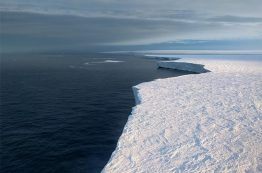School of Oceanography Assistant Professor Jodi Young is studying one of the most essential components of Antarctic ecosystems: sea ice algae. This algae supports the bottom of the food chains in polar regions, and if it were to suddenly disappear, dependent ecosystems could collapse. For two Oceanography graduate students, the chance to work with Young and collect sea ice algae data in one of the most remote and visually stunning regions on the planet was a twice in a lifetime experience.
Read more »Antarctic sea-ice models improve for the next IPCC, UW study shows
The world of climate modeling is complex, requiring an enormous amount of coordination and collaboration to produce. Models feed on mountains of different inputs to run simulations of what a future world might look like, and can be so big — in some cases, lines of code in the millions — they take days or weeks to run. Building these models can be challenging, but getting them right is critical for us to see where climate change is taking us, and importantly, what we might do about it.
Read more »First results from NASA’s ICESat-2 map 16 years of melting ice sheets
Using the most advanced Earth-observing laser instrument NASA has ever flown in space, a team of scientists led by the University of Washington has made precise measurements of how the Greenland and Antarctic ice sheets have changed over 16 years. In a new study published April 30 in the journal Science, researchers found the net loss of ice from Antarctica, along with Greenland’s shrinking ice sheet, has been responsible for 0.55 inches (14 millimeters) of sea level rise to the global ocean since 2003.
Read more at UW News »New radar technology sheds light on never-before-seen Antarctic landscape
17,000 years ago, Seattle was covered by an ice sheet that stood over 3,000 feet tall (for reference, the current tallest building in Seattle, the Columbia Tower, is just under 937 feet). As the ice advanced and eventually receded, it carved massive valleys, mountains and lakes into the earth to create the glaciated land and seascape we recognize today. These landscapes not only remind us of the area’s ancient glacial past but also provide tools to understand and predict future patterns for glaciers.
Read more »Polar bears in Baffin Bay skinnier, having fewer cubs due to less sea ice
Polar bears are spending more time on land than they did in the 1990s, due to reduced sea ice, new University of Washington-led research has found. Bears in Baffin Bay are getting thinner and adult females are having fewer cubs than was recorded at times when sea ice was more available. The new study published in Ecological Applications compares polar bear satellite tracking and visual monitoring data from the 1990s with more data collected in recent years.
Read more at UW News »





